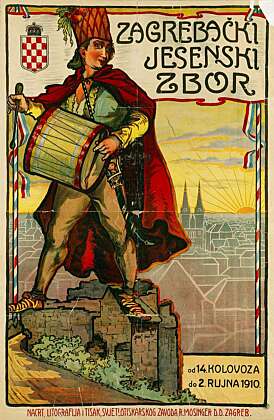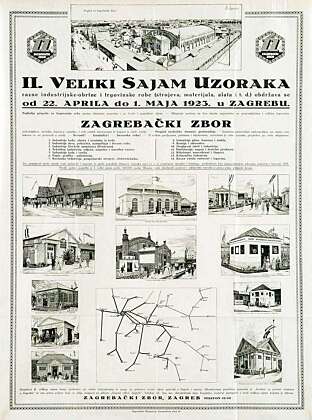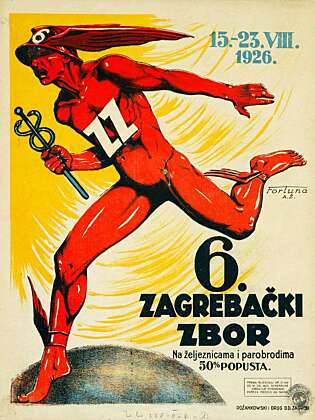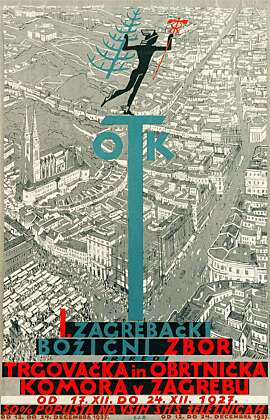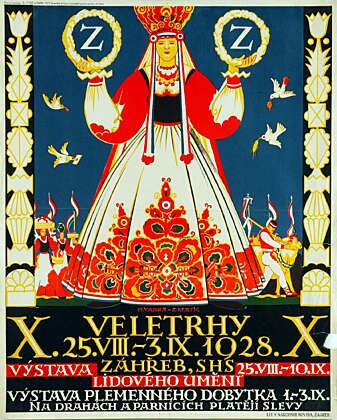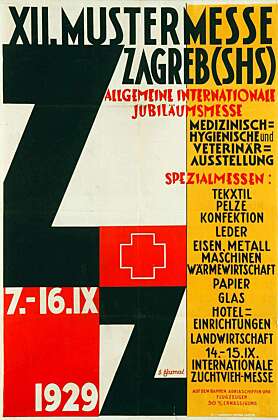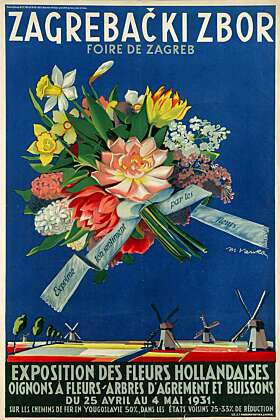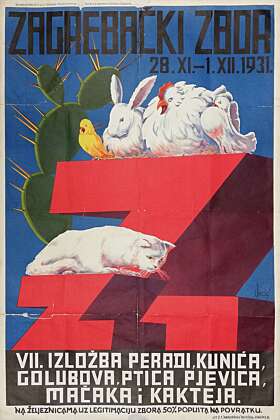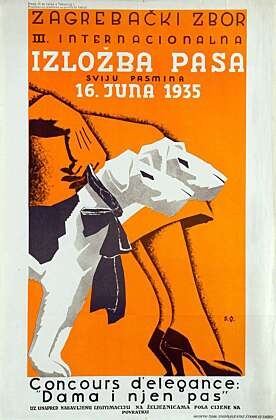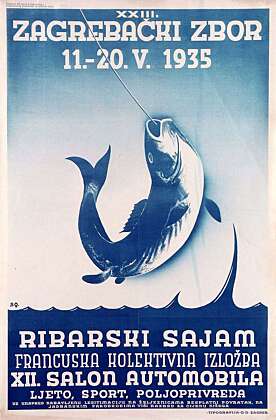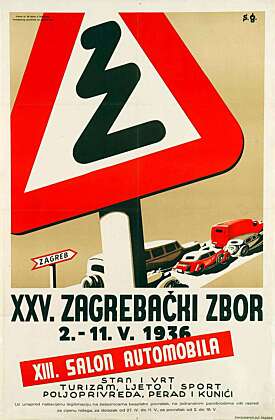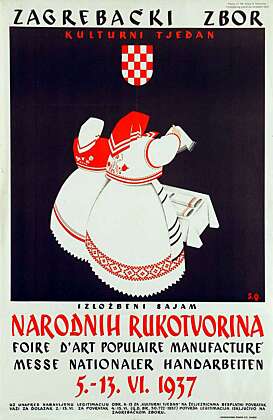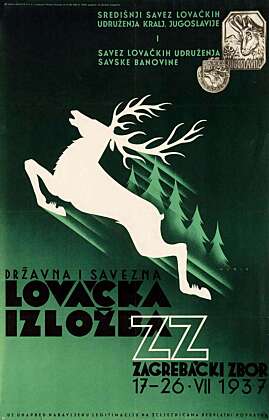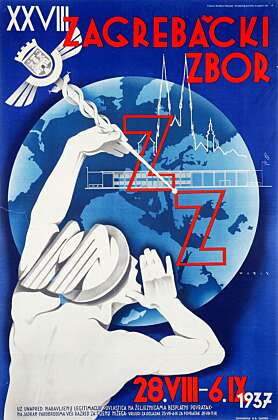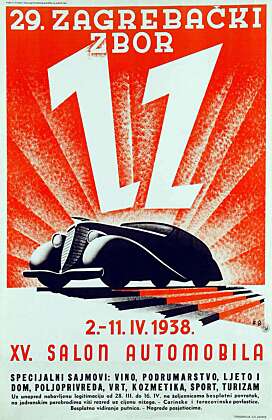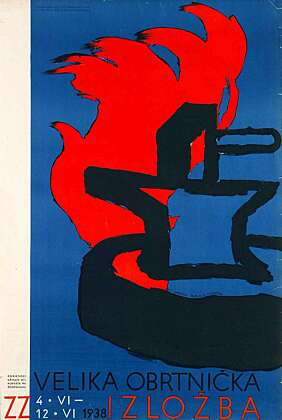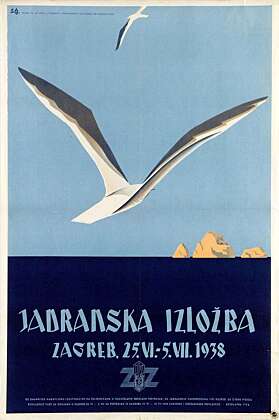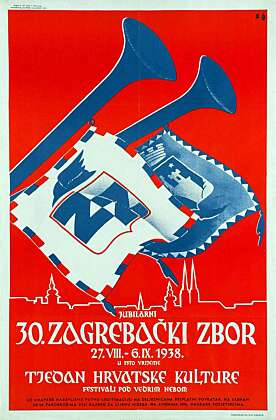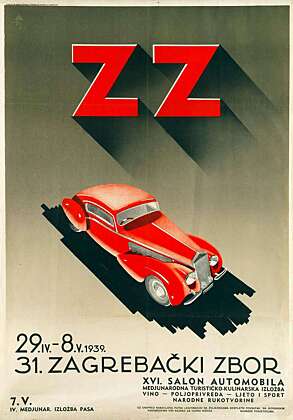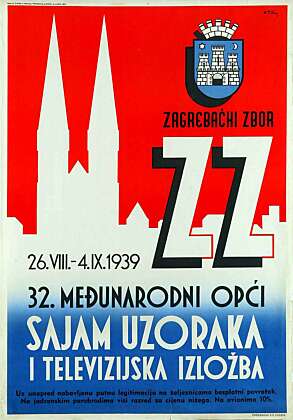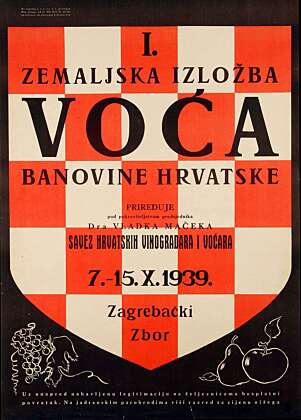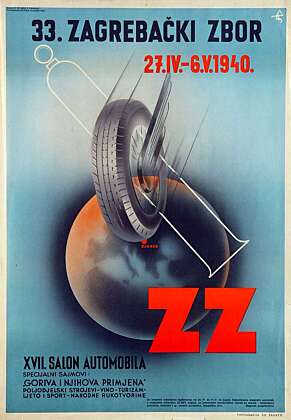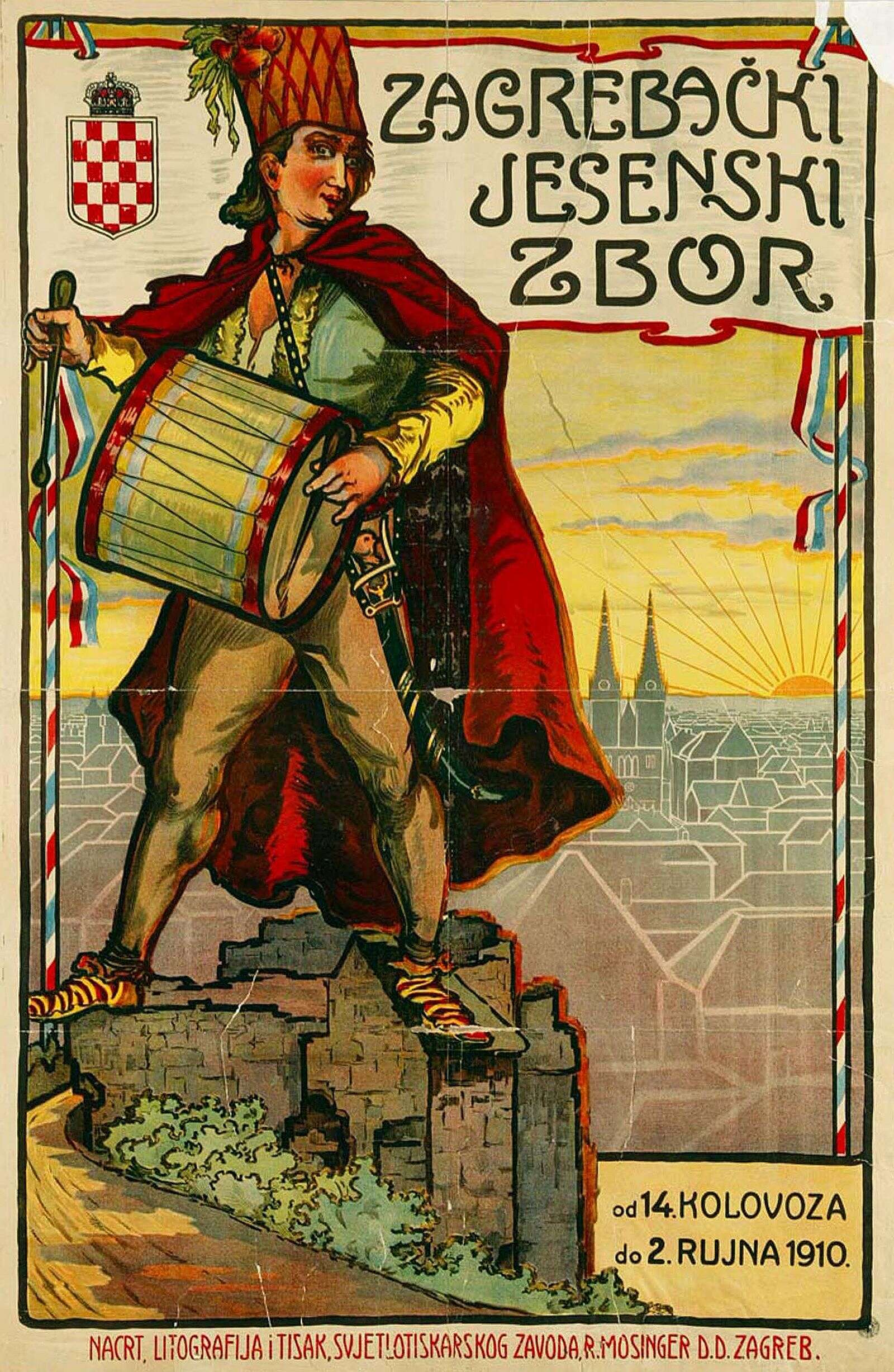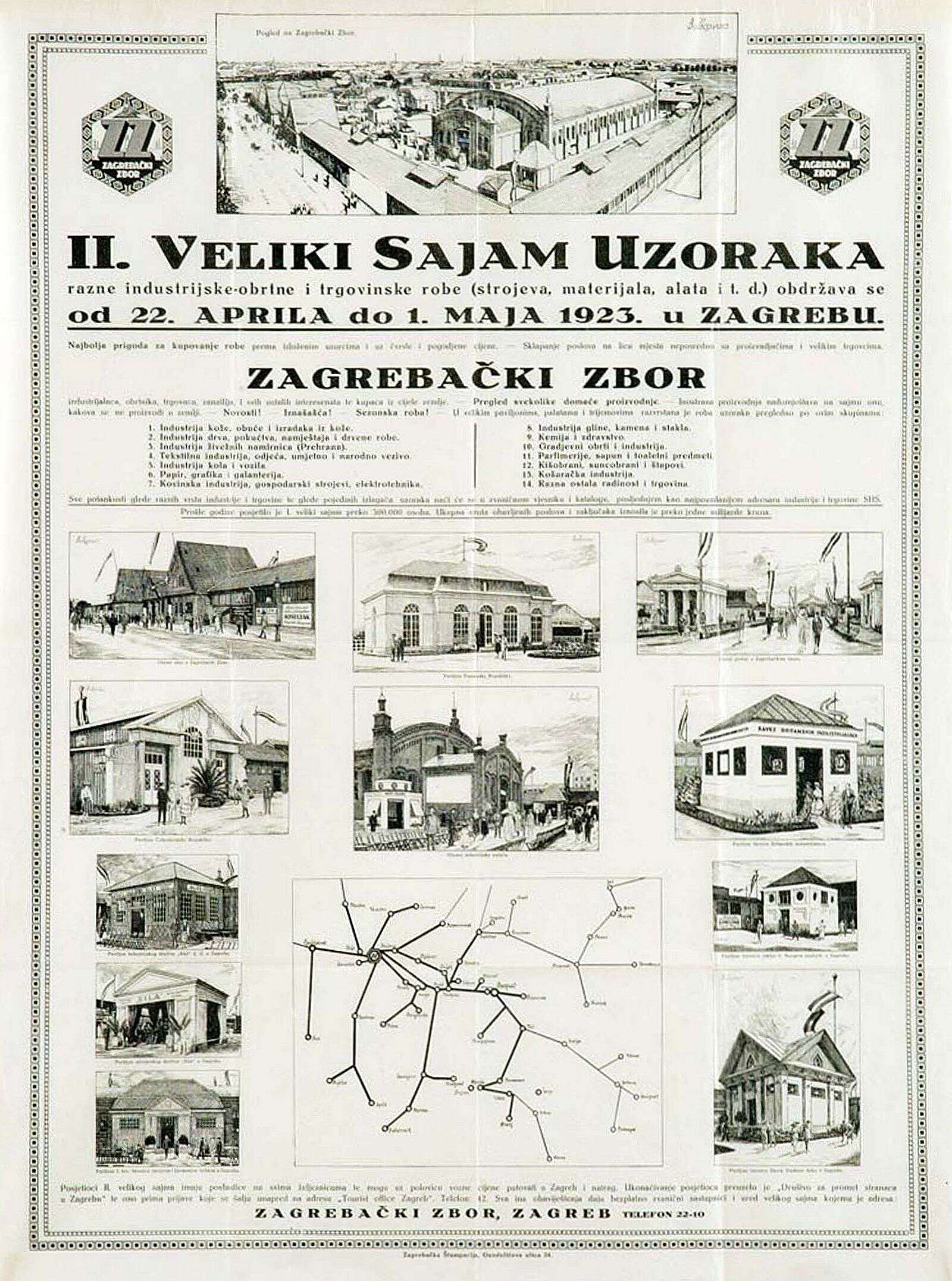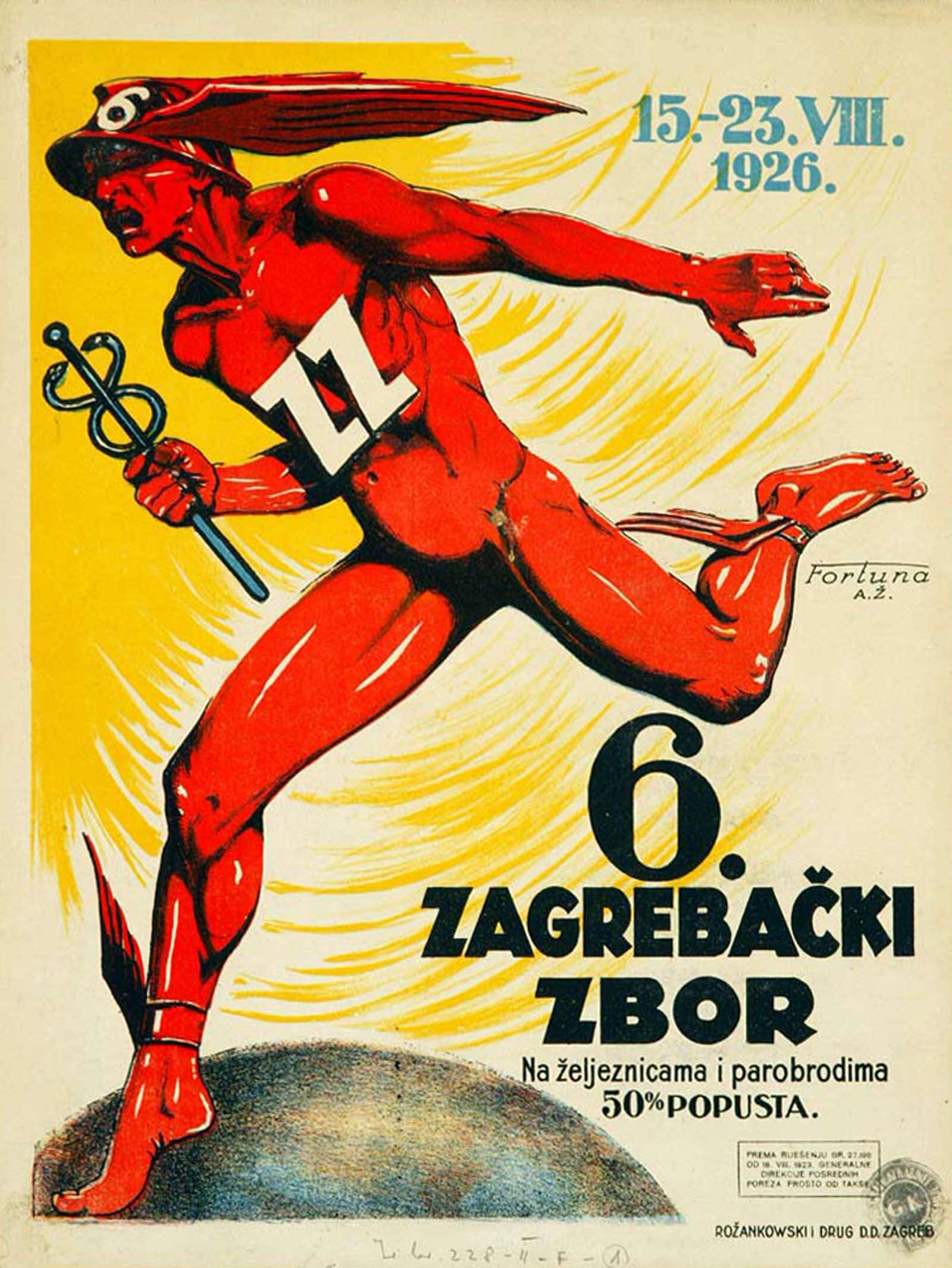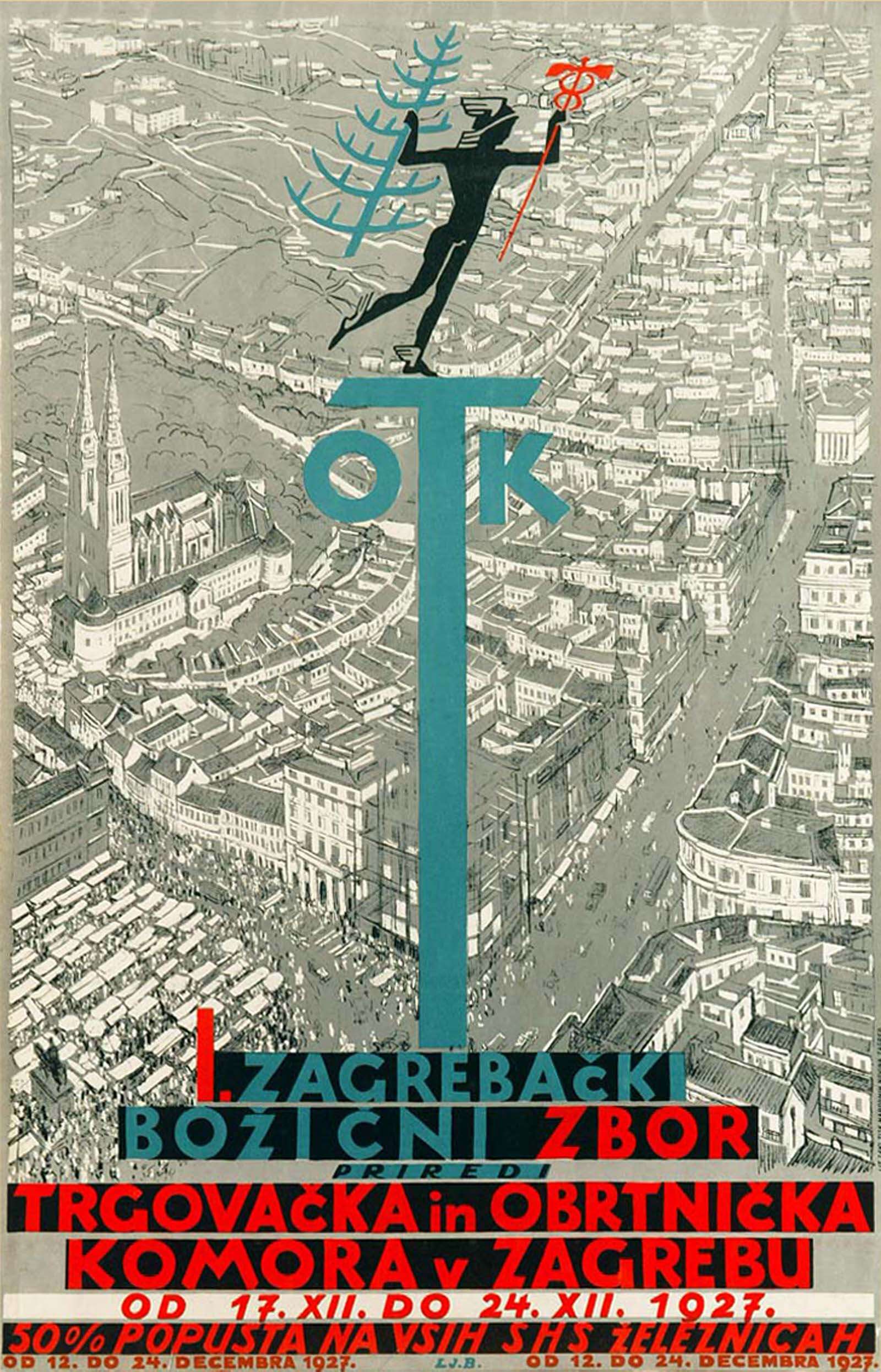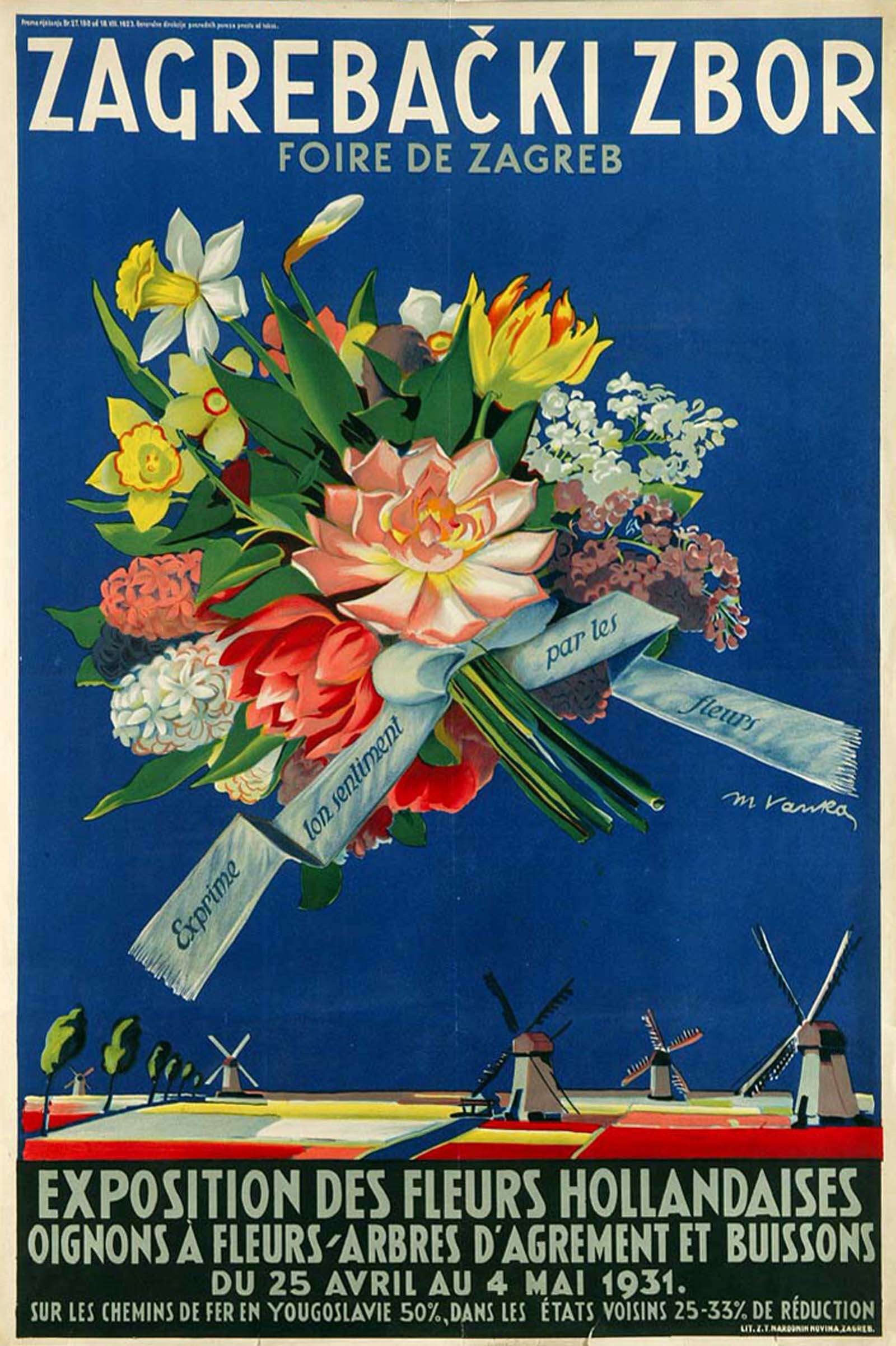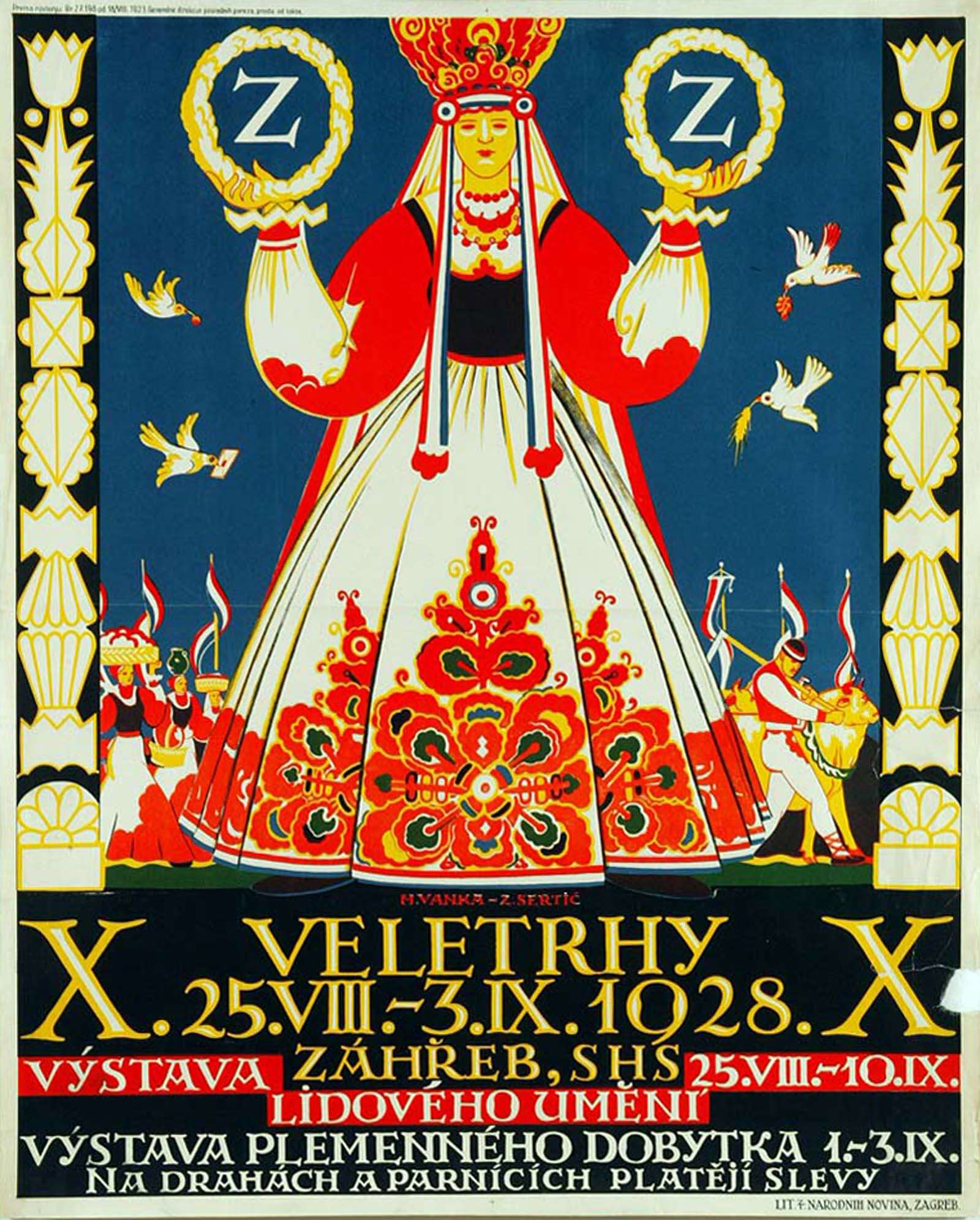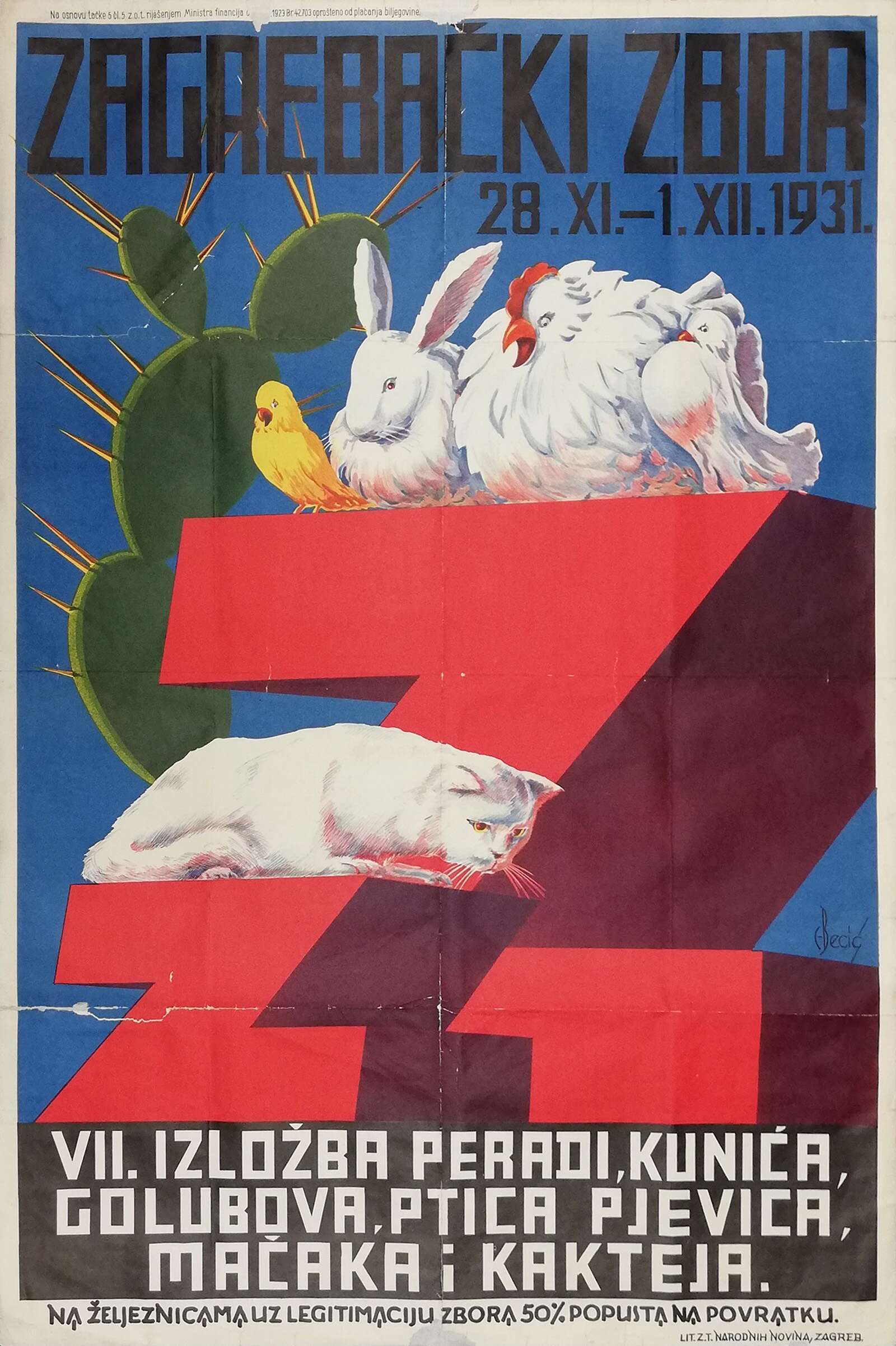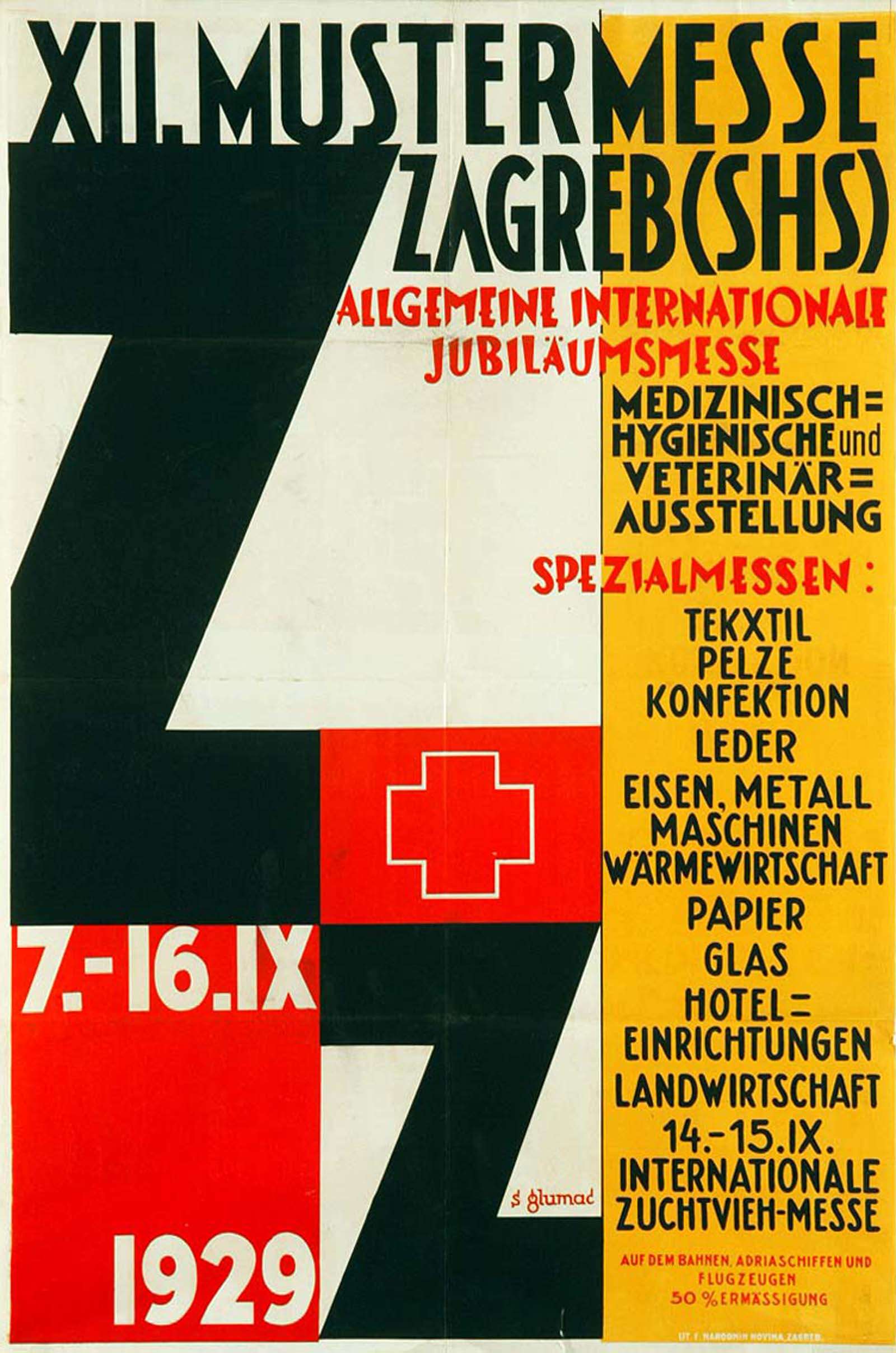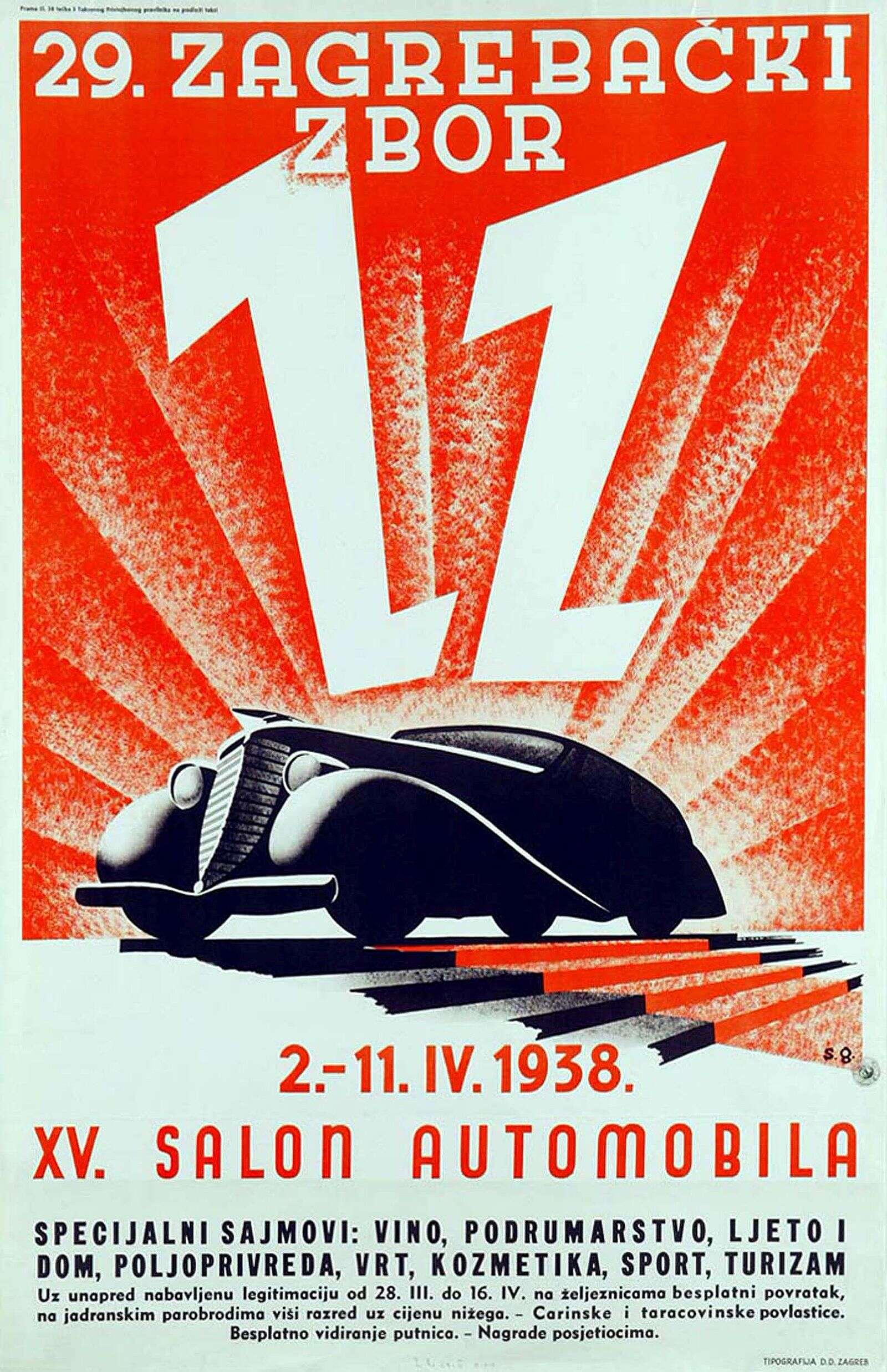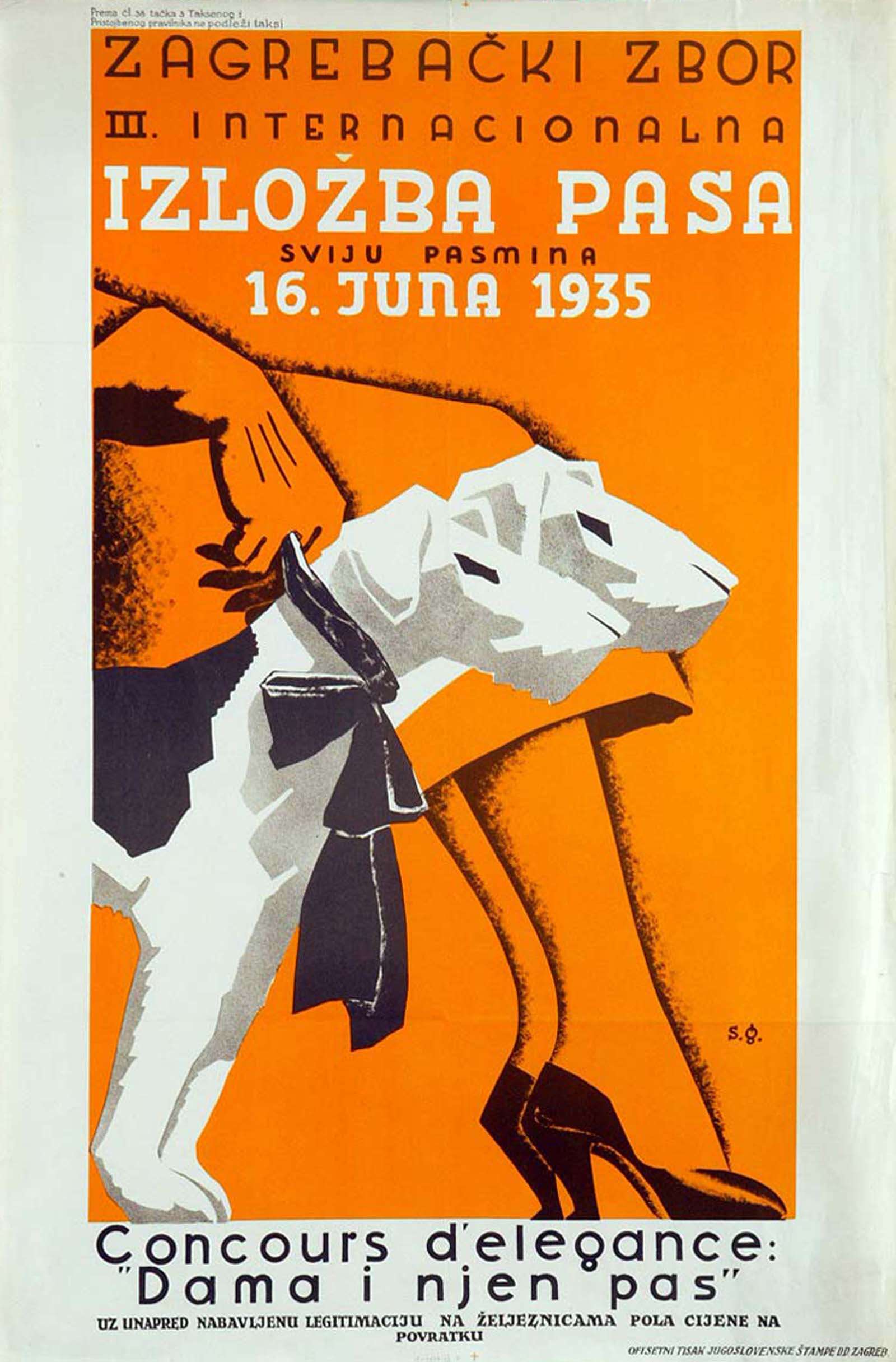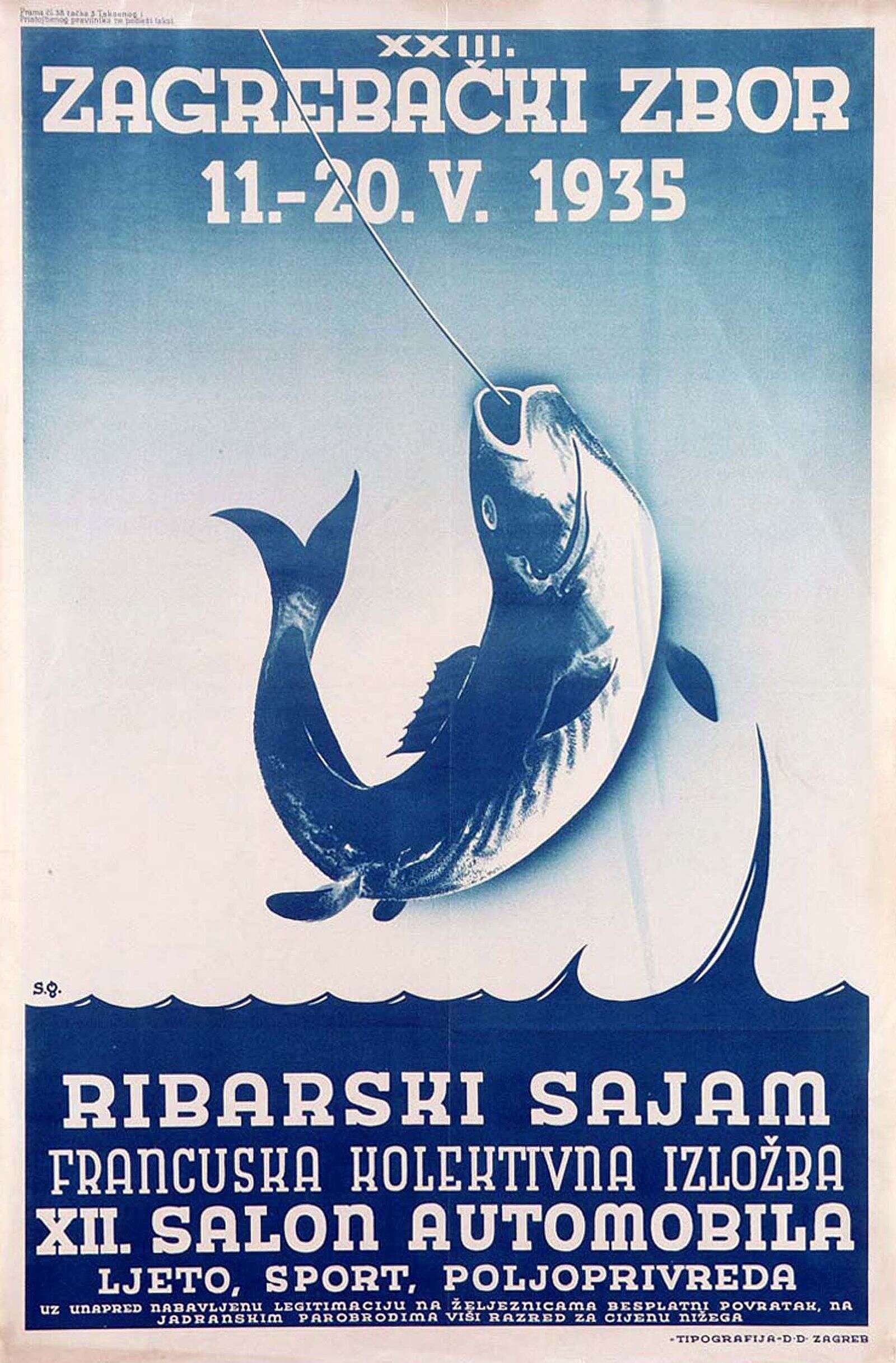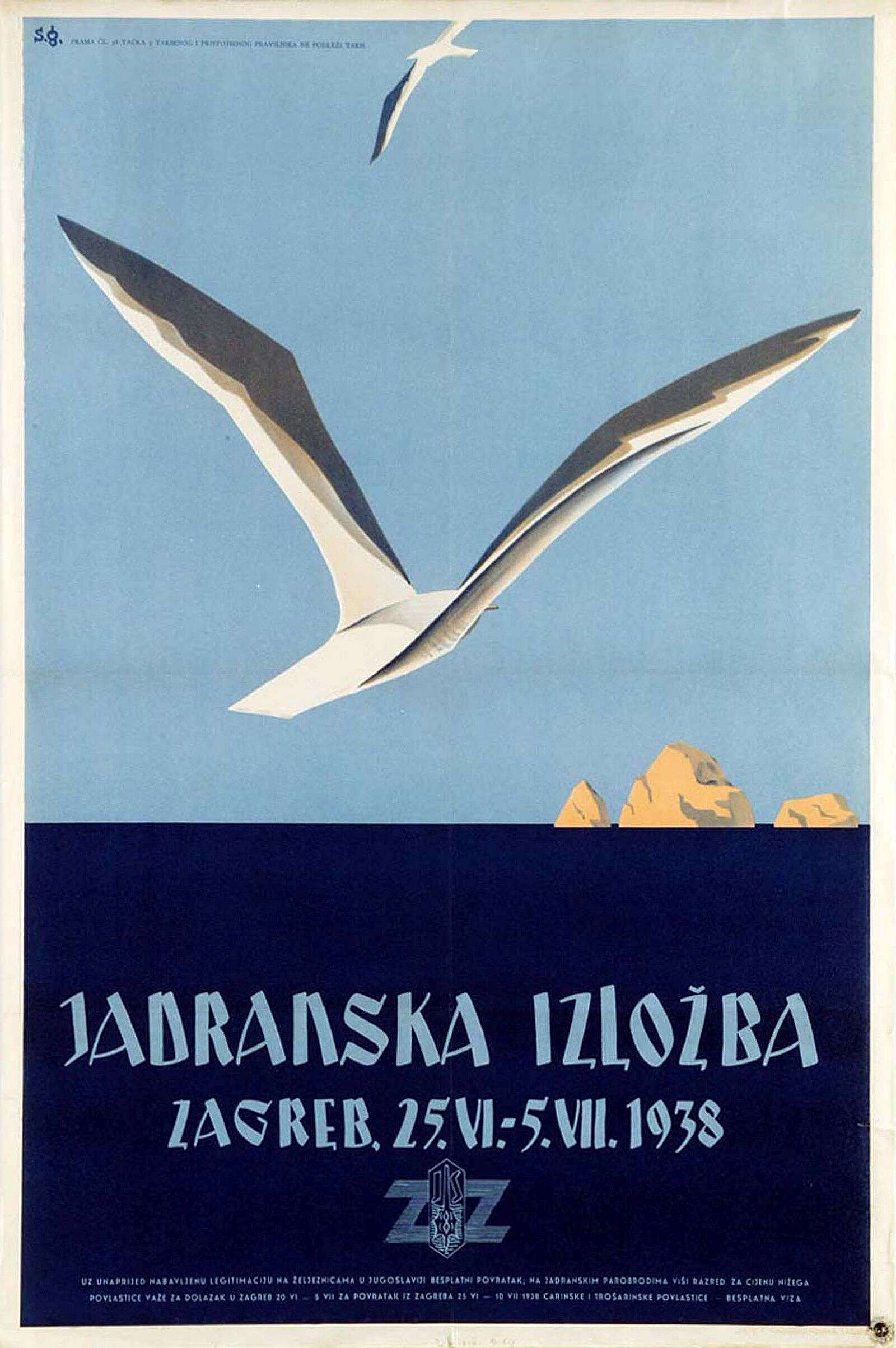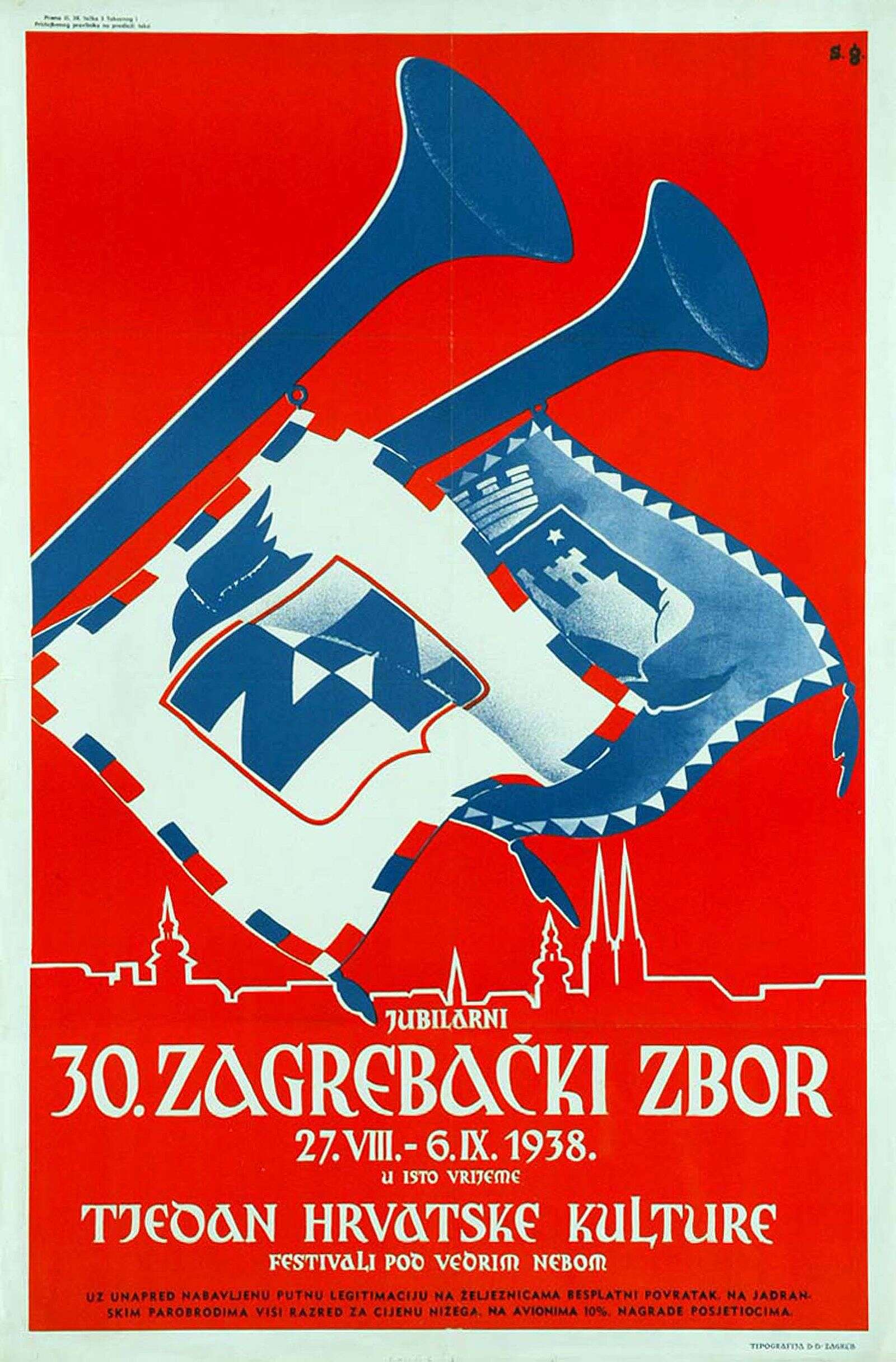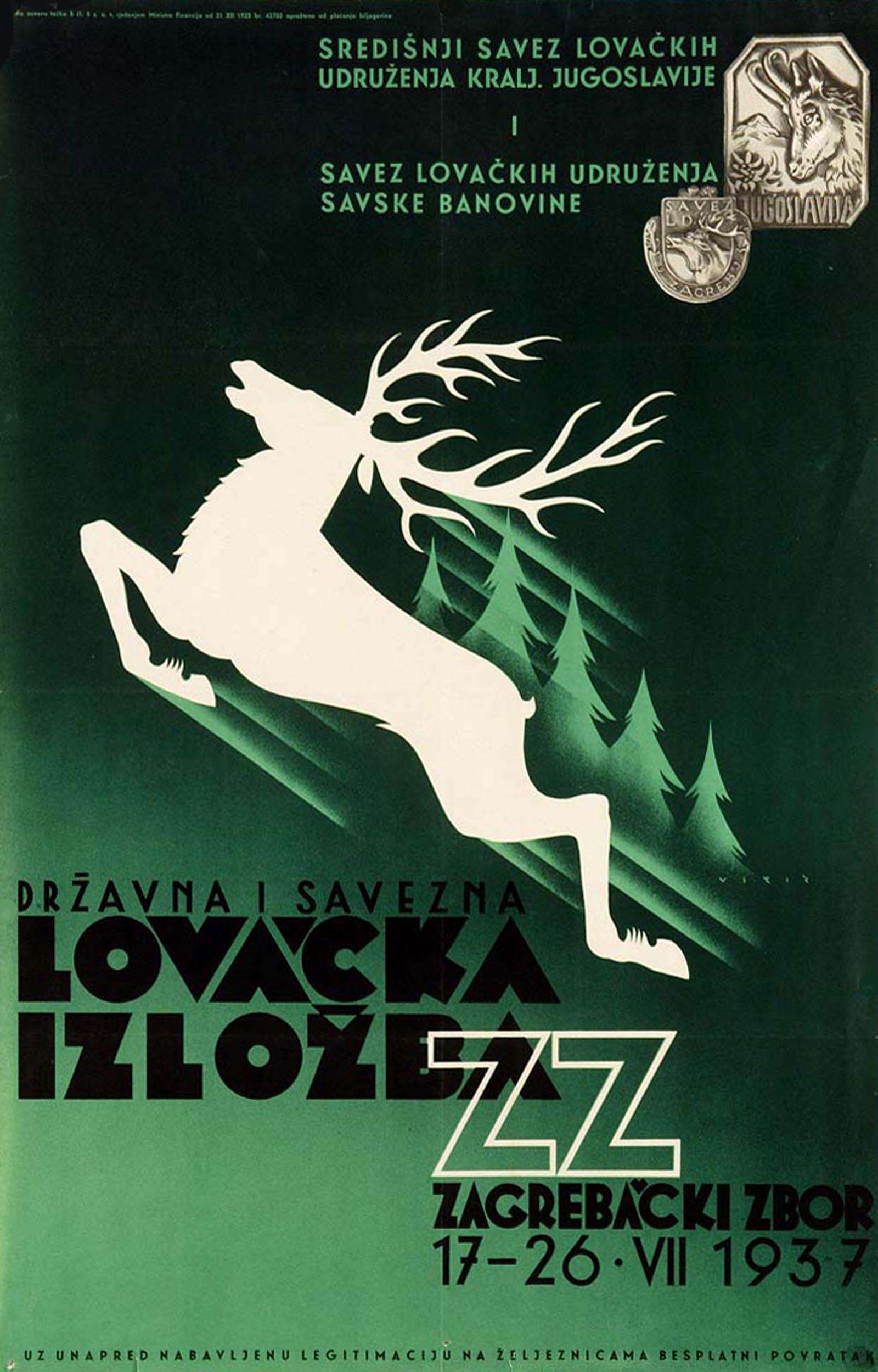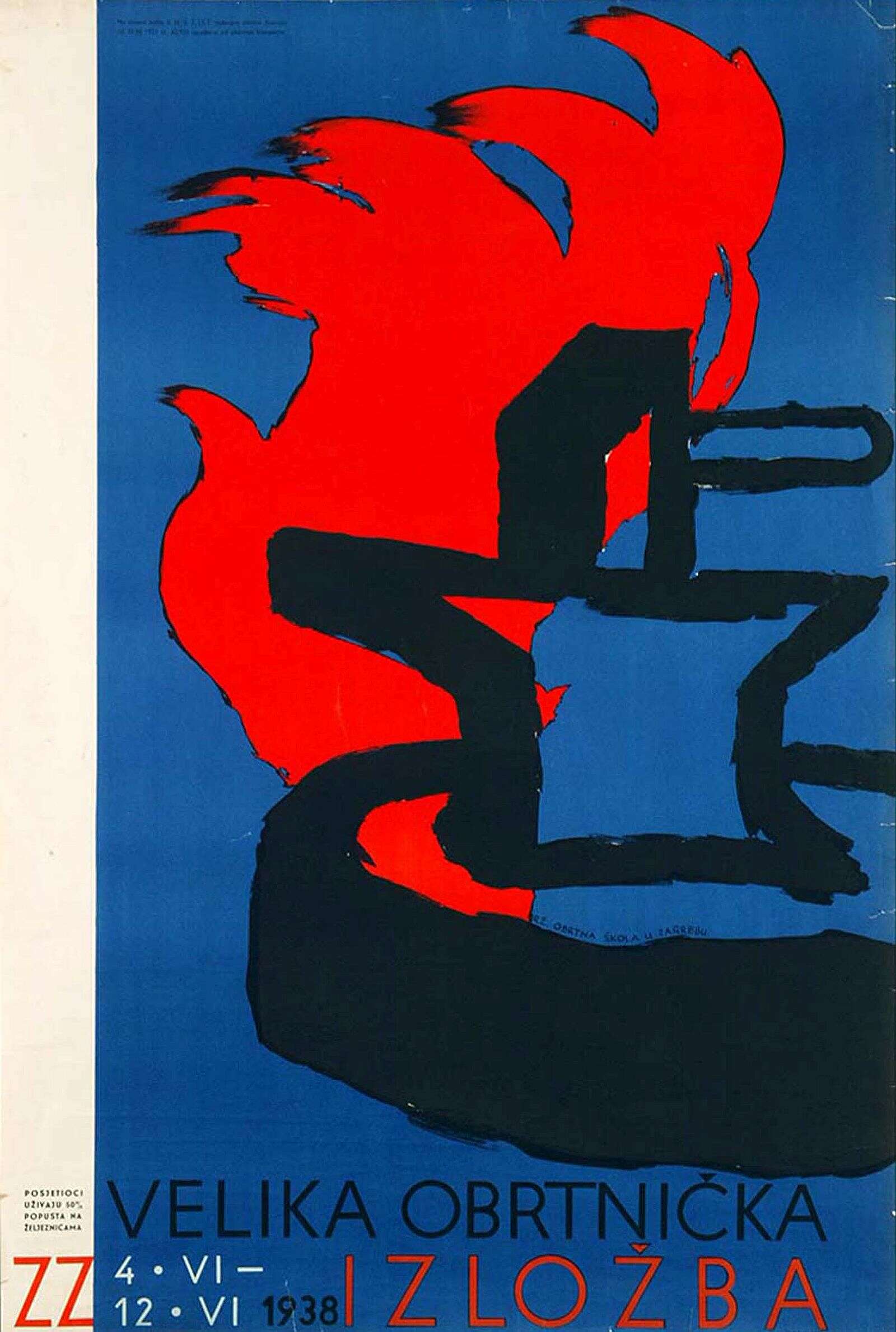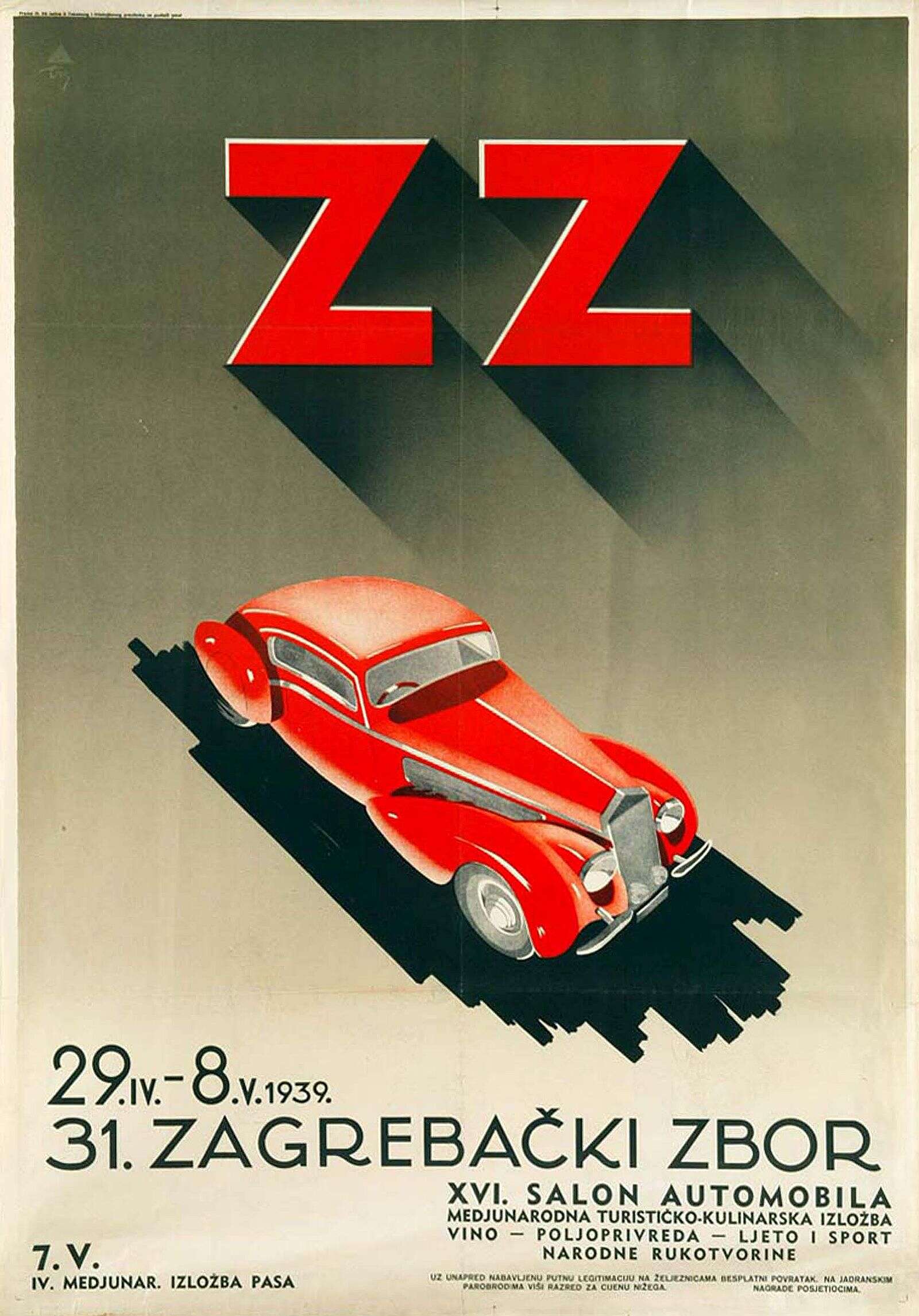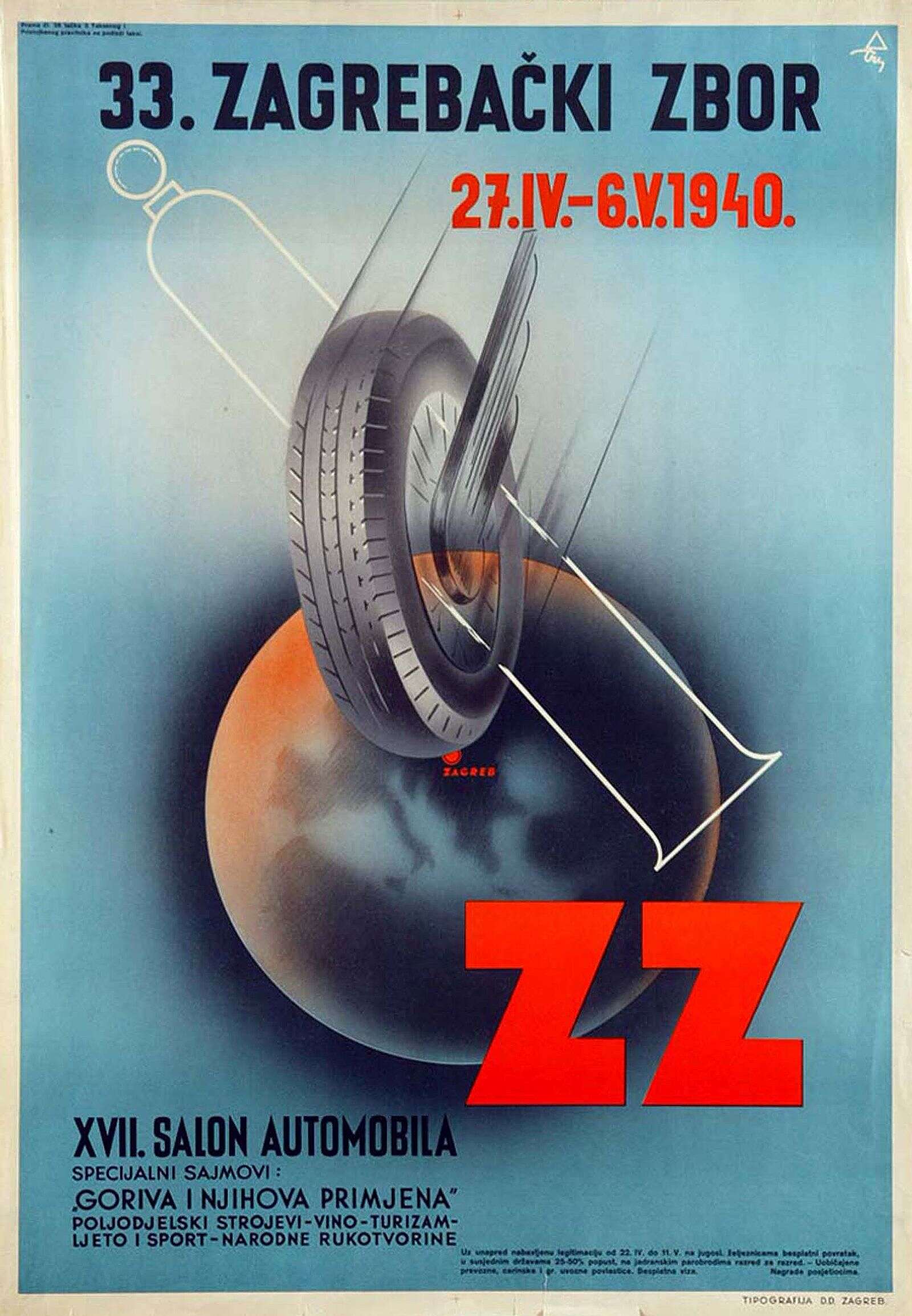Zagreb Assembly Trade Show Posters
The history of Zagreb as a trade show hub goes far beyond the establishment of the Zagreb Assembly. Organising trade shows intensified with the growth and development of the city and its economic activities, the booming industrialisation and the needs of the growing population. Along with popular small fairs which had already become a tradition in Zagreb, businessmen gathering around the Chamber of Trade and Crafts gradually came to the idea of hosting a larger event, so towards the end of the 19th century they started organising trade shows. The last big National Trade Show, held in 1906 between today’s Martić, Drašković and Rački Streets, was a forerunner of the upcoming Zagreb Assembly. Artists Menci Clement Crnčić and Branko Šenoa, accomplished graphic designers of the time, were commissioned to design the poster for this last trade show.[1] The monochromatic and detailed execution of their poster in the historicist manner and spirit of folklore tradition conveyed the idea of agricultural economic wealth and national belonging. In 1909, prominent businessmen, prompted by the then mayor of Zagreb, doctor Milan Amruš, established the Zagreb Assembly company with the objective of organising trade shows and large fairs aiming to improve trade, intensify the development of economy and industry and increase the circulation of foreigners in Zagreb.
The history of Zagreb as a trade show hub goes far beyond the establishment of the Zagreb Assembly. Organising trade shows intensified with the growth and development of the city and its economic activities, the booming industrialisation and the needs of the growing population. Along with popular small fairs which had already become a tradition in Zagreb, businessmen gathering around the Chamber of Trade and Crafts gradually came to the idea of hosting a larger event, so towards the end of the 19 th century they started organising trade shows. The last big National Trade Show, held in 1906 between today’s Martić, Drašković and Rački Streets, was a forerunner of the upcoming Zagreb Assembly. Artists Menci Clement Crnčić and Branko Šenoa, accomplished graphic designers of the time, were commissioned to design the poster for this last trade show.[1] The monochromatic and detailed execution of their poster in the historicist manner and spirit of folklore tradition conveyed the idea of agricultural economic wealth and national belonging.
In 1909, prominent businessmen, prompted by the then mayor of Zagreb, doctor Milan Amruš, established the Zagreb Assembly company with the objective of organising trade shows and large fairs aiming to improve trade, intensify the development of economy and industry and increase the circulation of foreigners in Zagreb. In 1910 the company hosted the first large Zagreb Autumn Assembly [cat. 1] , whose poster was designed by Rudolf Mosinger Collotype Institute. This vibrant large-scale lithograph depicts a messenger drummer inviting the public and announcing the trade show, with a schematised panoramic view of Zagreb in the background. The messenger, the drummer, would be replaced by Mercury in future posters, and the cityscape would remain as a motif present in different variations in the upcoming designs as well. The Assembly took place two more times, in 1911 and 1913, and its activities were abruptly terminated by the First World War. After the collapse of Austria-Hungary, in the post-war period, the Zagreb Assembly reappeared in new socio-political circumstances. From 1922 to the Second World War it grew to become one of the most important international economic events in our country and in this part of Europe.[2] The Assembly management hired graphic artist Pavao Bolkovac as the manager of the trade show’s promotional activities for 1922 and 1923.[3] As the author of the entire visual material for the Assembly, he designed the event’s trademark as well. Bolkovac’s poster for the Zagreb Assembly, the II Sample Fair (1923) [cat. 2] , features a stylised logo composed of the initial letters ZZ and a winged hat of the Roman god of trade and traffic, Mercury, along with a documentary-informative collage of realistic depictions of the fair’s pavilion and map.
The character of Mercury, often used in advertising foreign trade show events of the time,[4] appears as the central motif in the poster designed by the Fortuna Atelier in 1926 for the 6 th Zagreb Assembly [cat. 3] . The narrative composition with a dramatic figure flying across the world in a frenzy embodies the messenger of the Assembly, but also of the new industrial era.[5]
Mercury’s refined modified outline also appears in the poster for the I Zagreb Christmas Assembly [cat. 4] from 1927, designed by Ljubo Babić, who places the winged deity on the top of a typeface composition consisting of the organiser’s initials (Chamber of Trade and Crafts), with an aerial view of the cityscape opening below.
Between the 1920s and the Second World War many posters were made announcing specialised and occasional exhibitions organised by the Assembly, such as car shows, dog shows, traditional handicraft, flower, fruit shows etc. In line with thematic guidelines for specialised exhibitions, an entire series of posters of narrative-decorative compositions was born, such as the one for the Dutch Flower Show (1931) [cat. 7] by Maksimilijan Vanka, who also made the poster with national costume motifs, in association with artist and ethnographer Zdenka Sertić, for the X Zagreb Assembly and folk works exhibition (1928) [cat. 5] , or Kornel Becić’s design for the Zagreb Assembly, the VII Poultry, Pigeons, Songbirds, Cats and Cacti Show (1931) [cat. 8] .
In an analysis of the rich and superb interwar Assembly poster opus, Sergije Glumac’s works particularly stand out as the author with the biggest number of designs for the fair and trade shows. His posters (eight of which are kept in the holdings of the Department of Prints and Drawings) are deemed among the most important and finest creative pieces dedicated to this event. Glumac’s approach to graphic design and his concept cover a broad scope. The poster for the XII Zagreb Assembly (1929) [cat. 6] is an outstanding example of an avant-garde/constructivist approach based on geometrical forms and typography as an integral part of the composition. The qualities and design for the 29 th Zagreb Assembly, the XV Car Show (1938) [cat. 15] , as well as the elegant solution for the III International Dog Show (1933) [cat. 9] are close to the Art Deco aesthetic.
These examples, in addition to the posters for the XXII Zagreb Assembly, Fishing Fair (1935) [cat. 10] and Adriatic Exhibition (1938) [cat. 17] , where he applies figurative-symbolical content as a visual mediator of the trade show’s theme, or the poster for the 30 th Zagreb Assembly (1938) [cat. 18] , in which he uses elements to only connote the theme, illustrate the diversity of Glumac’s deliberations on advertisements and possible visual solutions.[6] Posters for specialised trade shows were designed by Emil Vičić, who included elements of photography next to a symbolical depiction in his composition for the State and Federal Hunting Show (1937) [cat. 13] , and Edo Murtić, whose stylised expressive design for the Big Craft Exhibition (1938) [cat. 16] was designed back while he was still a student at the School of Crafts, as well.
The finest examples of the Assembly’s poster production include posters by Atelijer Tri, the most important design studio around our areas in the thirties. It was founded by brothers Vladimir and Zvonimir Mirosavljević and Božidar Kocmut, and their activity follows up on the work of the Imago Advertising Institute. Atelijer Tri focused on scholarly, theoretical and practical research of advertising and made a large number of posters, ads and advertising campaigns. Their poster for the 31 st Zagreb Assembly, XVI Car Show (1939) [cat. 19] , in the finest Art Deco manner, as well as the poster for the 33 rd Zagreb Assembly, the XVII Car Show (1940) [cat. 22] , in which a stylised visual language accentuates speed and motion, are examples of functional and contemporarily considered advertising solutions.
The trade show activities of the Zagreb Assembly were put to a stop by the Second World War. When the war ended, the activities resumed under the name of Zagreb Fair. The Zagreb Assembly and its activities, apart from the economic role, played an important role in the socio-cultural development of the city. Having dedicated, as the organiser of different trade shows and exhibitions, special attention to event promotion, it commissioned an entire series of visual artists whose poster designs made history of the event and took an important place in the historical overview of graphic design in Croatia.
Vesna Kedmenec Križić
***
[1] The poster for this event is kept in the Collection of Posters of the Department of Prints and Drawings, Croatian Academy of Sciences and Arts, inv.no. 27-II.
[2] In 1925 the Zagreb Assembly was one of the founders of the international fair organisation Union des foires internationales (UFI).
[3] See more in: Magaš Bilandžić, Lovorka (2014), “Plakati Zagrebačkog zbora u međuratnom razdoblju (1922. – 1940.): prilog povijesti hrvatskog grafičkog dizajna”, Peristil, Zagreb, no. 57, pp. 209-211.
[4] For example, posters by Jakub František for the Prague fair (1926), Louis Raemakers for the annual industry fair in Utrecht (1928), or Piero Todeschini for the X Milan Sample Fair (1929).
[5] See more in: Magaš Bilandžić, Lovorka (2012), “Lik Merkura u hrvatskom grafičkom dizajnu između dva svjetska rata”, in: Metamorfoze mita. Mitologija u umjetnosti od srednjeg vijeka do moderne, Zbornik Dani Cvite Fiskovića, Department of Art History, Faculty of Humanities and Social Sciences, University of Zagreb, Zagreb, p. 175.
[6] See more in: Magaš Bilandžić, Lovorka (2019), Sergije Glumac grafika, grafički dizajn, scenografija, Croatian Society of Art Historians, Zagreb, pp. 237-252, and Galjer, Jasna (2004), “Plakati za Zagrebački zbor 1926. (Prilog redefiniranju povijesti hrvatskog plakata)”, Radovi Instituta za povijest umjetnosti, Zagreb, no. 28, pp. 336-347.
Zagreb Autumn Assembly, 1910
R. Mosinger Collotype Institute
Zagreb Assembly, II Sample Fair, 1923
Pavao Bolkovac
6th Zagreb Assembly, 1926
Fortuna Atelier
I Zagreb Christmas Assembly, 1927
Ljubo Babić
Zagreb Assembly, Dutch Flower Show, 1931
Maksimilijan Vanka
X Zagreb Assembly, 1928
Maksimilijan Vanka and Zdenka Sertić
XII Mustermesse Zagreb, 1929
Sergije Glumac
29th Zagreb Assembly, 1938.
Sergije Glumac
III International Dog Show, 1935
Sergije Glumac
XXIII Zagreb Assembly, 1935
Sergije Glumac
Adriatic Exhibition, 1938
Sergije Glumac
30th Zagreb Assembly, 1938
Sergije Glumac
State and Federal Hunting Show, 1937.
Emil Vičić
Big Craft Exhibition, 1938.
Edo Murtić
31st Zagreb Assembly, 1939
Atelijer Tri
33rd Zagreb Assembly, 1940
Atelijer Tri

